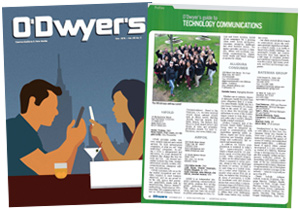|
|
According to a recent Forrester report, more than 6 billion text messages are sent each day in the United States. WhatsApp, a mobile messaging app with over 800 million global users, surpassed the daily average of sent SMS messages by 400% with over 30 billion messages sent per day. That’s 800 million reasons and 30 billion opportunities to listen and tap into the mobile messaging channel.
PR pros don’t need a handwritten invitation to know where the party is happening. There’s a laundry list of mobile messaging apps available for communicators to download, including WhatsApp, Facebook Messenger, Snapchat, Skype, Tango, Kik, Viber, Line and others. You can tune into conversations happening in real-time or provide exclusivity by engaging with your list of groups. Tango has a poll feature which allows publicists to reach their mobile messaging app audience to test for sentiment on new messaging or a logo.
|
|
Forget the argument of whether you need to phone pitch, email, or tweet a media contact. Listen in on the conversations that are happening in mobile messaging apps, fine-tune your messaging targeted to millennials, and pitch away. As long as the message is on point, you’ll get heard.
Forget B2B and B2C, start thinking B2Me
Public relations pros who have been in the game for over 20 years need to either hand over the controls or download one of the readily available free mobile messaging apps and start paying attention to what Millennials are saying to each other and as a group. The holy grail of Millennial media, BuzzFeed, isn’t just distributing content via social and producing shareable videos and click-hole quizzes, they’re also in the messaging app space. They host public chats on the popular private messaging app, Viber, where users can follow, share, invite, and engage on the conversation real-time or catch up afterwards. Viber also allows users to follow public chats hosted by celebrities and other media companies such as Perez Hilton and Mashable.
Tango, a mobile messaging app that has over 100 million active users, also has public conversations called Rooms, which users can search and join based on either interests or location. There’s also Sysomos and Brandwatch, a new wave of listening tools that have already hit the mobile scene.
The goal of listening to Millennials and Centennials on messaging apps isn’t about identifying the “what you can do for me or what can I do for you” but rather “what can you say to me that will resonate and inspire me to make a move?” We have entered the B2Me movement, where individuals want to be heard and receive messages tailored to them. Are you getting the message yet?
Don’t let the message fall on deaf ears
Here’s what we know: Millennials are mobile, social, and global. They don’t like to be interrupted with traditional advertising; they like to feel as though they’re making the choice to engage with a brand. The use of cell phones worldwide is ever-growing and billions of messages are getting sent each day.
It’s time for communications professionals to step out of their comfort zone and start tuning into the conversations happening in mobile messaging apps before Millennials start tuning them out. People don’t like faceless companies. They like to communicate with other people. Interaction via messaging apps is more personal; messages are unique and tailored to the audience. Communicators or brand managers can start using apps such as Tango or Viber to monitor and understand what millennials are saying to refine their brand messaging. For the most part, these messaging apps are free to download and use so why aren’t more PR professionals listening? It’s time to listen before you speak.
Here’s a cheat sheet of mobile messaging apps Millennials use so you can tune in by participating in conversations prior to perfecting your pitches:
List of mobile messaging apps
• WhatsApp (Global). The app is more popular than texting (SMS), handling more than 30 billion messages a day.
• Facebook Messenger (Global). More than 33% of Millennials use the app, which provides brands an alternative to reaching the younger generations since they tend not to use the social network as a whole. The app has more than 500 million users.
• Snapchat (Global). With a monthly audience of 100 million people, the mobile app supports video chat, allows users to send cash to each other, and hosts popular branded content in their “Discover” hub.
• WeChat (China). The fifth most popular messaging app reaching 468 million people on a monthly basis. About 60% of youngsters in China turn to this app to get their mobile messaging fix.
• Skype (Global). The 12-year-old global video, audio, and chat communications service is used by a quarter of teens and adults between the ages of 17 and 31.
• Viber (Global). The app is a global mobile monthly audience of 236 million and recently added the feature “public chats” where individuals can engage with public broadcasts from celebrities, such as Perez Hilton, and media companies, such as Buzzfeed.
• LINE (Japan). This mobile messaging app is most popular in Japan, Thailand, and Taiwan and currently has over 181 million users. The company is aggressively advertising in the United States to obtain more users.
• Kik (North America). On average, users spend 35 minutes per session in the app, besting Facebook Messenger and Snapchat whose users spend 27 and 21 minutes per session.
• Kakao Talk (South Korea). Like other mobile messaging apps, Kakao features stickers and games but also has its own gift shop, a polling tool, mobile payment services, and “Plus Friend”, a feature for following brands, media companies, and celebrities.
• Tango (United States). The app extends beyond users communicating with friends with a feature for viewing people nearby, member profiles, and a news feed.
Due to the fact that it is even harder to reach out to younger generations with interruption-based ads, instant messaging is an efficient way to reach and engage with them.
Brands can deliver tailored offers and announcements to targeted audience segments via mobile messaging apps. Video dominates in private messages so consider a 6-15 second ad with a strong call-to-action. Social media is a human-to-human communication channel.
Mobile messaging applications are free to download and use, with the exception of purchasing stickers or WhatsApp membership fee after one year of usage. There’s great potential for this channel to be a valuable revenue stream for brands. Brands need to make their messaging direct, personal, and actionable to entice direct and mobile messaging users. Remember, it is no longer B2B or B2C marketing; you’re now living in the Millennial world of B2Me — so make it personal.
* * *
Aljolynn Sperber is Director of Social Media at Marketing Maven.




 Laura Anderson, who rose to VP/GM of global communications and events in a nearly 20 year stint at Intel, will take on the Americas technology chair at Burson following the completion of the BCW and H+K merger on July 1.
Laura Anderson, who rose to VP/GM of global communications and events in a nearly 20 year stint at Intel, will take on the Americas technology chair at Burson following the completion of the BCW and H+K merger on July 1. WE Communications has partnered with ROKK Solutions to form the WE ROKK AI service.
WE Communications has partnered with ROKK Solutions to form the WE ROKK AI service. In the dynamic world of modern business, effective communication is a pivotal tool for success across various industries. At Communications Strategy Group (CSG®), our expertise in embracing innovation in communication extends beyond traditional marketing strategies, paving the way for transformative industry-specific solutions.
In the dynamic world of modern business, effective communication is a pivotal tool for success across various industries. At Communications Strategy Group (CSG®), our expertise in embracing innovation in communication extends beyond traditional marketing strategies, paving the way for transformative industry-specific solutions. There are two types of tech PR professionals. Which one are you? And are C-suite executives making that decision for you?
There are two types of tech PR professionals. Which one are you? And are C-suite executives making that decision for you? While there’s an impulse to grab reporters’ attention with the newest industry-transforming tech product or service, a back-to-basics approach focused on telling the right stories to the right people is a far more successful way to ensure your technology campaign breaks through the clutter of today’s crowded tech landscape.
While there’s an impulse to grab reporters’ attention with the newest industry-transforming tech product or service, a back-to-basics approach focused on telling the right stories to the right people is a far more successful way to ensure your technology campaign breaks through the clutter of today’s crowded tech landscape.


 Have a comment? Send it to
Have a comment? Send it to 
No comments have been submitted for this story yet.